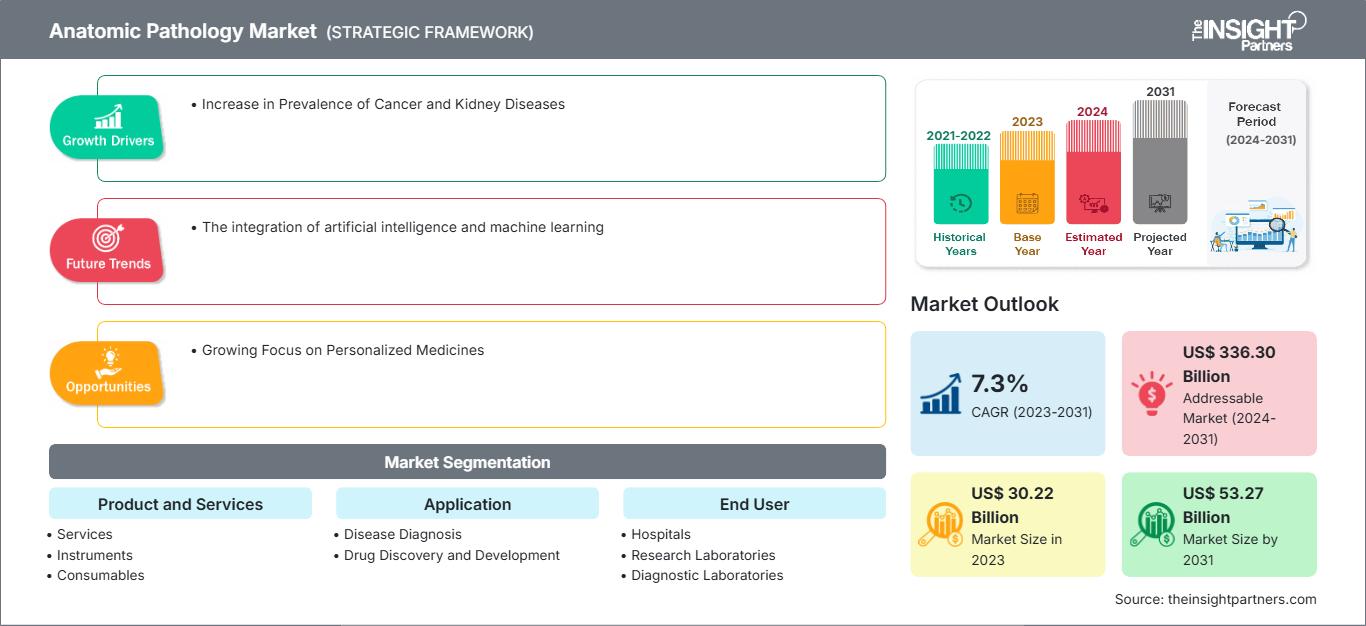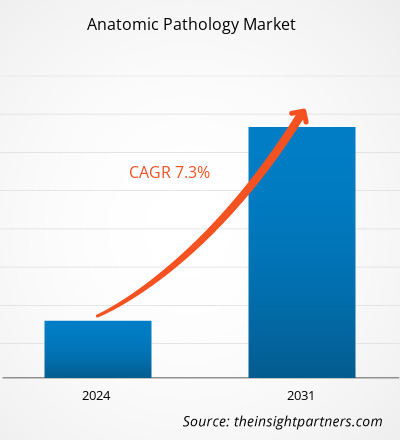Der Markt für anatomische Pathologie soll von 30,22 Milliarden US-Dollar im Jahr 2023 auf 53,27 Milliarden US-Dollar im Jahr 2031 anwachsen. Für den Zeitraum 2023–2031 wird eine durchschnittliche jährliche Wachstumsrate (CAGR) von 7,3 % erwartet. Die Integration von künstlicher Intelligenz und maschinellem Lernen dürfte ein zukünftiger Markttrend sein.
Marktanalyse für anatomische Pathologie
Innovationen bei Diagnosetechniken – einschließlich digitaler Pathologie, Molekulardiagnostik und Bildgebungstechnologien – verbessern die Genauigkeit und Effizienz pathologischer Dienste und treiben das Wachstum des Marktes für anatomische Pathologie voran. Eine alternde Bevölkerung ist anfälliger für verschiedene Krankheiten, was zu einer erhöhten Nachfrage nach pathologischen Diensten für genaue Diagnosen und Behandlungsplanung führt. Darüber hinaus treiben ein gestiegenes Bewusstsein für Gesundheitsprobleme, robuste Screening-Programme für eine frühzeitige Diagnose, unterstützende regulatorische Rahmenbedingungen und günstige Erstattungsrichtlinien das Wachstum des Marktes für anatomische Pathologie voran.
Marktüberblick über anatomische Pathologie
Indien wird voraussichtlich die höchste durchschnittliche jährliche Wachstumsrate (CAGR) auf dem Gesamtmarkt verzeichnen. Der Bericht des National Cancer Registry Programme Report 2020 prognostizierte für Indien eine Krebserkrankungsrate von 14,61 Millionen im Jahr 2022. Der Bericht gab auch an, dass die Krebsinzidenz bis 2025 im Vergleich zu 2020 voraussichtlich um 12,8 % steigen wird. Angesichts der steigenden Krebsrate und der Fortschritte in der Gesundheitsinfrastruktur konzentrieren sich die Regierungsbehörden in Indien darauf, den Menschen einen erweiterten Zugang zu Gesundheitslösungen zu bieten. Laut Angaben des Ministeriums für Industrie- und Binnenhandelsförderung (DPIIT) beliefen sich die ausländischen Direktinvestitionen (FDI) in die Arzneimittel- und Pharmaindustrie von April 2000 bis Dezember 2020 auf insgesamt 17,74 Milliarden US-Dollar. Unternehmen, Organisationen und Regierungen investieren zudem erheblich in diagnostische Dienstleistungen und moderne Diagnoseeinrichtungen. Investitionen im Gesundheitssektor fördern somit das Wachstum des indischen Marktes für anatomische Pathologie.
Passen Sie diesen Bericht Ihren Anforderungen an
Sie erhalten kostenlos Anpassungen an jedem Bericht, einschließlich Teilen dieses Berichts oder einer Analyse auf Länderebene, eines Excel-Datenpakets sowie tolle Angebote und Rabatte für Start-ups und Universitäten.
Markt für anatomische Pathologie: Strategische Einblicke

-
Holen Sie sich die wichtigsten Markttrends aus diesem Bericht.Dieses KOSTENLOSE Beispiel umfasst Datenanalysen, die von Markttrends bis hin zu Schätzungen und Prognosen reichen.
Markttreiber und -chancen für die anatomische Pathologie
Zunahme der Prävalenz von Krebs und Nierenerkrankungen
Die anatomische Pathologie ist nützlich, um Anomalien zu erkennen, die bei der Diagnose von Krankheiten wie Autoimmunerkrankungen, Nieren- und Lebererkrankungen sowie Krebs helfen können. Die Histopathologie, bei der krankheitsbedingte Gewebeveränderungen untersucht werden, ist ein wichtiger Teil der anatomischen Pathologie. Krebs hat weltweit erhebliche Auswirkungen auf die Gesellschaft. Die Belastung der Gesundheitssysteme durch Krebs nimmt weltweit deutlich zu, da Krebs eine der häufigsten Todesursachen ist. Die Weltgesundheitsorganisation (WHO) stuft Krebs als zweithäufigste Todesursache weltweit ein. Laut Daten des World Cancer Research Fund International wurden im Jahr 2022 weltweit etwa 20 Millionen neue Krebsfälle registriert. Darüber hinaus sind laut den von der Weltgesundheitsorganisation (WHO) veröffentlichten Daten im Jahr 2020 weltweit fast 10 Millionen Todesfälle durch Krebs verursacht worden. Das National Center for Health Statistics schätzt, dass die Zahl der neu diagnostizierten Krebsfälle in den USA im Jahr 2024 voraussichtlich 2 Millionen erreichen wird. Darüber hinaus werden im Jahr 2024 in den USA voraussichtlich etwa 0,61 Millionen Menschen an Krebs sterben. Laut den von Macmillan Cancer Support veröffentlichten Daten wird in Großbritannien jedes Jahr bei etwa 392.000 Menschen Krebs diagnostiziert, während jedes Jahr etwa 167.000 Menschen an der Krankheit sterben.
Die Prävalenz chronischer Nierenerkrankungen nimmt aufgrund der Zunahme der geriatrischen Bevölkerung zu. Laut den Centers for Disease Control and Prevention litten im Jahr 2023 in den USA etwa 35,5 Millionen Menschen an chronischen Nierenerkrankungen. Die Biopsie, eine anatomisch-pathologische Technik, wird zur Erkennung von Krebs und chronischen Nierenerkrankungen eingesetzt. Aufgrund der zunehmenden Verbreitung von Krebs und Nierenerkrankungen sind Regierungsbehörden, Gesundheitsdienstleister und Institutionen gezwungen, Initiativen zur Diagnose und Behandlung dieser Krankheiten zu unterstützen. Somit treibt ein Anstieg der Verbreitung von Krebs und anderen zielgerichteten Krankheiten wie Autoimmunerkrankungen und Nieren- und Lebererkrankungen das Wachstum des globalen Marktes für anatomische Pathologie voran.
Wachsender Fokus auf personalisierte Medikamente bietet Marktchancen
Personalisierte Medikamente werden hauptsächlich unter Berücksichtigung des genetischen Profils von Personen entwickelt, um Entscheidungen hinsichtlich der Prävention, Diagnose und Behandlung einer Krankheit zu treffen. Sie bieten Arzneimittelherstellern die Möglichkeit, Wirkstoffe für Patientengruppen zu entwickeln, die nicht wie vorgesehen auf Medikamente reagieren oder bei denen herkömmliche medizinische Verfahren nicht wie erwartet anschlagen. Vieles deutet darauf hin, dass ein erheblicher Teil der Variabilität der Arzneimittelreaktion von genetisch kontrollierten Faktoren abhängt, darunter Alter, Ernährung, Umwelteinflüsse und Gesundheitszustand. Die Genomik spielt eine wichtige Rolle bei der Entwicklung personalisierter Medikamente, da die Kenntnis des genetischen Profils eines Patienten Ärzten bei der Auswahl geeigneter Medikamente hilft. Personalisierte Medikamente tragen zur Verbesserung der Gesundheitsversorgung bei, indem sie jedem Patienten frühere Diagnosen, Risikobewertungen und optimale Behandlungen ermöglichen.
Pathologen spielen eine wichtige Rolle bei der Entwicklung und praktischen Umsetzung molekularer und genomischer Tests. Personalisierte Medikamente werden zur Behandlung von Krankheiten wie Brustkrebs und Herz-Kreislauf-Erkrankungen eingesetzt. Personalisierte Krebsmedikamente weisen weniger und weniger schwerwiegende Nebenwirkungen auf als andere Behandlungsarten, da sie auf eine spezifischere Wirkung ausgelegt sind. Mit den fortschreitenden Fortschritten in Forschung und klinischen Studien dürften personalisierte Medikamente zudem ein noch größeres Potenzial zur Verbesserung der Patientenversorgung erreichen. Daher wird erwartet, dass der zunehmende Fokus auf personalisierte Medizin das Wachstum des Marktes für anatomische Pathologie ankurbelt.
Segmentierungsanalyse des Marktberichts zur anatomischen Pathologie
Schlüsselsegmente, die zur Ableitung der Marktanalyse für anatomische Pathologie beigetragen haben, sind Produkte und Dienstleistungen, Anwendung und Endbenutzer.
- Basierend auf Produkten und Dienstleistungen ist der Markt für anatomische Pathologie in Instrumente, Verbrauchsmaterialien und Dienstleistungen segmentiert. Das Dienstleistungssegment ist weiter in Histopathologie und Zytopathologie unterteilt. Das Instrumentensegment ist weiter unterteilt in Mikrotome und Kryostaten, automatische Färbegeräte, Gewebeprozessoren und Sonstiges. Das Instrumentensegment hatte 2023 den größten Marktanteil.
- Nach Anwendung ist der Markt in Krankheitsdiagnose, Arzneimittelforschung und -entwicklung und Sonstiges segmentiert. Das Segment Krankheitsdiagnose hatte 2023 den größten Marktanteil.
- Basierend auf dem Endbenutzer ist der Markt für anatomische Pathologie in Krankenhäuser, Forschungslabore, Diagnoselabore und Sonstiges unterteilt. Das Segment Krankenhäuser hatte 2023 den größten Marktanteil.
Marktanteilsanalyse für anatomische Pathologie nach Geografie
Der geografische Umfang des Marktberichts für anatomische Pathologie ist hauptsächlich in fünf Regionen unterteilt: Nordamerika, Asien-Pazifik, Europa, Süd- und Mittelamerika sowie Naher Osten und Afrika. Nordamerika dominierte den Markt im Jahr 2023. Das Wachstum des Marktes in dieser Region ist auf die zunehmende Verbreitung von Krebs, zunehmende staatliche Initiativen zur Krebsvorsorge, den zunehmenden Fokus auf effiziente Krankheitsdiagnose und den steigenden Bedarf an fortschrittlichen Gesundheitssystemen zurückzuführen. Darüber hinaus werden verstärkte Forschungs- und Entwicklungsanstrengungen der Marktteilnehmer sowie Produkteinführungen voraussichtlich das Wachstum des Marktes für anatomische Pathologie in Nordamerika im Prognosezeitraum vorantreiben. Akteure auf dem US-amerikanischen Markt für anatomische Pathologie konzentrieren sich kontinuierlich auf die Entwicklung innovativer und praktischer Instrumente und Verbrauchsmaterialien für pathologische Verfahren. Im November 2023 stellte Illumina Inc., ein weltweit führendes Unternehmen für DNA-Sequenzierung und Array-basierte Technologien, TruSight Oncology 500 ctDNA v2 (Plattennummer 1 ctDNA v2) vor, eine neue Version seines verteilten Flüssigbiopsie-Tests, der eine umfassende nichtinvasive genomische Profilierung zirkulierender Tumor-DNA aus dem Blut ermöglicht und so gewebebasierte Tests ergänzt. Der asiatisch-pazifische Raum wird im Prognosezeitraum voraussichtlich die höchste durchschnittliche jährliche Wachstumsrate (CAGR) verzeichnen.
Anatomische Pathologie
Regionale Einblicke in den Markt für anatomische PathologieDie Analysten von The Insight Partners haben die regionalen Trends und Faktoren, die den Markt für anatomische Pathologie im Prognosezeitraum beeinflussen, ausführlich erläutert. In diesem Abschnitt werden auch die Marktsegmente und die geografische Lage in Nordamerika, Europa, dem asiatisch-pazifischen Raum, dem Nahen Osten und Afrika sowie Süd- und Mittelamerika erörtert.
Umfang des Marktberichts zur anatomischen Pathologie
| Berichtsattribut | Einzelheiten |
|---|---|
| Marktgröße in 2023 | US$ 30.22 Billion |
| Marktgröße nach 2031 | US$ 53.27 Billion |
| Globale CAGR (2023 - 2031) | 7.3% |
| Historische Daten | 2021-2022 |
| Prognosezeitraum | 2024-2031 |
| Abgedeckte Segmente |
By Produkte und Dienstleistungen
|
| Abgedeckte Regionen und Länder |
Nordamerika
|
| Marktführer und wichtige Unternehmensprofile |
|
Dichte der Marktteilnehmer im Bereich anatomische Pathologie: Verständnis ihrer Auswirkungen auf die Geschäftsdynamik
Der Markt für anatomische Pathologie wächst rasant. Die steigende Nachfrage der Endverbraucher ist auf Faktoren wie veränderte Verbraucherpräferenzen, technologische Fortschritte und ein stärkeres Bewusstsein für die Produktvorteile zurückzuführen. Mit der steigenden Nachfrage erweitern Unternehmen ihr Angebot, entwickeln Innovationen, um den Bedürfnissen der Verbraucher gerecht zu werden, und nutzen neue Trends, was das Marktwachstum weiter ankurbelt.

- Holen Sie sich die Markt für anatomische Pathologie Übersicht der wichtigsten Akteure
Marktnachrichten und aktuelle Entwicklungen im Bereich der anatomischen Pathologie
Der Markt für anatomische Pathologie wird durch die Erhebung qualitativer und quantitativer Daten aus Primär- und Sekundärforschung bewertet, die wichtige Unternehmenspublikationen, Verbandsdaten und Datenbanken umfasst. Einige der Entwicklungen auf dem Markt sind unten aufgeführt:
- Agilent Technologies Inc. ist eine Partnerschaft mit Hamamatsu Photonics KK eingegangen, einem führenden Anbieter von Whole Slide Imaging-Systemen. Die Zusammenarbeit umfasste die Integration der NanoZoomer-Reihe von Hamamatsu, einschließlich des S360MD Slide-Scanner-Systems, in die digitale Pathologielösung von Agilent. Die Ergänzung der NanoZoomer Slide-Scanner-Systeme, die Glasobjektträger durch Hochgeschwindigkeitsscannen in hochauflösende digitale Daten umwandeln, vervollständigt Agilents Angebot eines offenen und agnostischen digitalen Pathologie-Workflows, der Durchbrüche in der Präzisionsmedizin beschleunigen soll. (Quelle: Agilent Technologies Inc., Unternehmenswebsite, März 2023)
- Epredia, eine Tochtergesellschaft der PHC Corporation, und NovaScan, Inc., ein Unternehmen, das bahnbrechende Technologien zur Krebserkennung und -stratifizierung entwickelt, gaben die Unterzeichnung einer Absichtserklärung für einen exklusiven US-Vertriebsvertrag für MarginScan bekannt, ein Medizinprodukt, das Ärzte bei der Echtzeiterkennung von nicht-melanozytärem Hautkrebs unterstützt. Epredia hat Avantik, ein auf die Unterstützung von Diagnoselaboren spezialisiertes Unternehmen, beauftragt, dieses neue Gerät in die Hände von Mohs-Chirurgen zu bringen. (Quelle: PHC Corporation, Unternehmenswebsite, Mai 2024)
Bericht zum Markt für anatomische Pathologie: Umfang und Ergebnisse
Der Bericht „Marktgröße und Prognose für anatomische Pathologie (2021–2031)“ bietet eine detaillierte Analyse des Marktes und deckt die folgenden Bereiche ab:
- Marktgröße und Prognose für anatomische Pathologie auf globaler, regionaler und Länderebene für alle abgedeckten wichtigen Marktsegmente
- Markttrends für anatomische Pathologie sowie Marktdynamik wie Treiber, Einschränkungen und wichtige Chancen
- Detaillierte PEST- und SWOT-Analyse
- Marktanalyse für anatomische Pathologie mit wichtigen Markttrends, globalen und regionalen Rahmenbedingungen, wichtigen Akteuren, Vorschriften und aktuellen Marktentwicklungen
- Branchenlandschaft und Wettbewerbsanalyse mit Marktkonzentration, Heatmap-Analyse, prominenten Akteuren und aktuellen Entwicklungen für den Markt für anatomische Pathologie
- Detaillierte Unternehmensprofile
- Historische Analyse (2 Jahre), Basisjahr, Prognose (7 Jahre) mit CAGR
- PEST- und SWOT-Analyse
- Marktgröße Wert/Volumen – Global, Regional, Land
- Branchen- und Wettbewerbslandschaft
- Excel-Datensatz
Aktuelle Berichte
Erfahrungsberichte
Grund zum Kauf
- Fundierte Entscheidungsfindung
- Marktdynamik verstehen
- Wettbewerbsanalyse
- Kundeneinblicke
- Marktprognosen
- Risikominimierung
- Strategische Planung
- Investitionsbegründung
- Identifizierung neuer Märkte
- Verbesserung von Marketingstrategien
- Steigerung der Betriebseffizienz
- Anpassung an regulatorische Trends






















 Kostenlose Probe anfordern für - Markt für anatomische Pathologie
Kostenlose Probe anfordern für - Markt für anatomische Pathologie